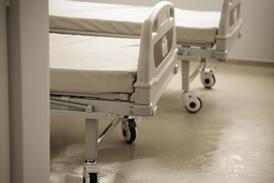Standardised business case guided by a national strategy can fast-track procurement of robotic systems within the NHS and drive meaningful change
In April 2022, my hospital, West Hertfordshire Teaching Hospitals Trust implemented its first surgical robotics programme following the purchase of two Versius Systems. From the beginning, we were surprised at how quickly we’ve been able to implement the programme and feel the benefits. We have both systems operating lists concurrently across multiple different surgical specialties most days of the week, enabling us to bring the benefits of robotic-assisted surgery to more patients.
Across the country, hospitals are feeling the strain. This is particularly pertinent to the surgical field where backlogs and pandemic recovery continue to plague the NHS.1 As a consultant surgeon, I have seen the pressures my colleagues and the wider NHS are facing, and the importance of introducing innovative technologies to support efficiency and deliver positive outcomes for patients, protect our workforce and reduce costs on the system to deliver better value-based healthcare. Having felt the impact a robotics programme can have, I am a strong advocate for the development of initiatives such as a national strategy that will democratise access to robotic surgery.
Sponsored by
Traditionally, robotics has been limited to metropolitan hubs – big teaching hospitals linked to internationally renowned universities and research institutions that may have a lower volume of cases in comparison to regional centres, or trusts that have received systems as the result of generous charitable donations. The concentration of new technology in inner-city institutions, which don’t always have the bed space to perform a high volume of surgeries, translates to a postcode lottery for patients elsewhere. There is a large, untapped potential for robotic programmes to be established in regional centres that do have high volumes of cancer procedures due to supporting wider catchment areas. To make this happen, there is a need for a national directive to support robotics uptake as it continues to become the norm so that regional centres aren’t left behind and patients across the country can experience the benefits RAS can provide.
By bringing technology into those regional trusts through a national directive, sites can also attract top talent to build out teams and provide patients with a wider range of services. We’ve experienced this here at West Herts, where we’ve previously had issues recruiting upper gastrointestinal tract surgeons, which meant that our waiting lists started to increase. We’ve now been able to competitively fill posts based on a desire from surgeons to operate robotically, who have now built an active Upper GI robotics stream as part of our programme. We have seen the implementation of this programme transform our workplace morale and have had members of the wider surgical team, such as nurses, want to develop their skillset and retrain into new robotic nurse assistant roles, to allow themselves a higher involvement in the programme.
Throughout the procurement process, our trust board remained incredibly enthusiastic and supportive of the robotics programme. Having positive senior management engagement spurred us on to make the programme a real success, but it was complex with significant time commitment – over 18 months to get a final business case across the line.

A robotics programme is a significant investment, and while every trust has different directives and needs that they need to cater for, an agreed set of benefits across providers could be hugely beneficial and would avoid people spending prolonged periods in a time-poor system, compiling evidence to build their business case that already exists. A standardised business case guided by a national strategy could fast-track procurement of robotic systems within the NHS and drive meaningful change – especially in smaller trusts that haven’t had much exposure to the benefits of robotic programmes and wouldn’t otherwise benefit.
As programmes like ours continue to flourish, the collection and analysis of real-world evidence is vital in not only establishing a national strategy but also for the efficient ongoing evaluation of the clinical and economic value of surgical robots to improve care for patients once a programme is up and running. To support this, infrastructure needs to be levelled up to ensure we can effectively collect data and insights provided by robotic systems to support the needs of our patients and help us to standardise care – industry will play a vital role in ensuring that this will happen.
We, along with colleagues, have proven that you can have a multispecialty programme outside of a big metropolitan centre. We’ve seen the positive impact a national strategy can have, in Wales. There’s a diverse group of stakeholders supporting the uptake of a national strategy in England,2 and the meaningful impact a programme could have in creating more equitable access that will improve standards of care. The question therefore is – what is stopping us from establishing a national robotics strategy in England to future proof our NHS?
References:
1NHS England. Thousands of beds taken up every day as NHS contends with ‘perfect storm’ of winter pressures. 1 December 2022. [Cited December 2022] https://www.england.nhs.uk/2022/12/thousands-of-beds-taken-up-every-day-as-nhs-contends-with-perfect-storm-of-winter-pressures/
2Association of British HealthTech Industries Ltd. ABHI White Paper: Robotic-Assisted-Surgery and New Models of Surgical Care. February 2022. Available from: https://www.abhi.org.uk/media/3450/ras-white-paper.pdf





























No comments yet